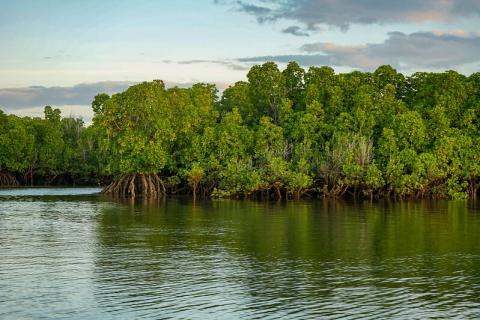Ecosystem-based adaptation: A promising solution to flood risk in African cities
Ecosystem-based adaptation: A promising solution to flood risk in African cities
Urban floods are becoming more common as a result of increasing urbanisation, poor urban planning, and climate change. A new report by PlanAdapt explores how the cities of Cape Town, Durban, Mombasa and Nairobi are rising to the challenge, and how their work can inspire others.
Understanding flood management
Flooding poses a significant threat to cities in the global South, due to a combination of factors including unplanned city extensions, prevalent poverty and low adaptive capacity.
Depending on the location, physical characteristics, and climate change risk of different urban areas, they can be affected by different types of flooding.
Rapid urbanisation challenges the ability of cities to learn from past mistakes and build adaptive capacity. Nevertheless, there is a broad range of interventions and measures to reduce flood risk at different scales.
PlanAdapt, supported by CDKN, undertook a comparative study of four African cities and their approaches to flood risk: Cape Town, Durban, Mombasa and Nairobi. The study is now being used for valuable exchange and peer learning among district and municipal officials in those South African and Kenyan cities.
It is also being used in Accra, Ghana, where CDKN has been working with municipal officials who are eager to benefit from peer learning – and the report has the potential to benefit many other cities.
Ecosystem-based Flood Management: a comparative study report of Cape Town and Durban (South Africa), Nairobi and Mombasa (Kenya) highlights the use of Integrated Flood Risk Management (IFRM) approaches such as ecosystem-based adaptation. IFRM involves a combination of infrastructural elements as well as non-structural elements (changes to institutions, processes and plans) to reduce flood risk and improve resilience to floods.
Climate change has led to more erratic rainfall in the cities concerned. Ecosystem-based approaches aim to restore and enhance the natural dynamics of ecosystems to buffer the adverse impacts of climate change. These approaches can provide many environmental, socioeconomic, and biodiversity benefits, as well as flood risk management solutions.
Specifically, ecosystem-based approaches such as restoration of rivers, mangroves and sand dunes, and protection of kelp beds and wetlands, have demonstrated wider benefits for communities through improvements to public health, the protection of livelihoods and creation of new income-generating opportunities.
Ecosystem-based approaches are sometimes referred to as ‘green infrastructure’, in contrast to conventional ‘grey infrastructure’ solutions such as pouring concrete for sea walls and river canalisation, and so forth.

Learning from South African and Kenyan cities
While Durban, Cape Town, Mombasa and Nairobi each has its own political, social and cultural context, they find themselves facing similar challenges when it comes to flooding. In both South Africa and Kenya, rapid urbanisation leads to an increase in impervious surfaces and areas with a lack of solid waste management or insufficient drainage systems. Informal settlements located in flood-prone areas are particularly affected. These challenges are exacerbated further by climate change impacts such as heavy rainfall and droughts.
Bearing these similarities in mind, it is useful to understand how each of the selected cities responds to its particular circumstances with a combination of both green and grey infrastructure and non-infrastructure solutions. Collaborative modes of governance that embrace a whole-of-society perspective appear to be most effective.
An integrated approach
Flood and water governance require the involvement of a wide range of stakeholders and institutions as well as intra- and cross-organisational collaboration, sometimes over a long period of time. It is vital that practitioners and officials inform the process of knowledge-gathering, and establishing an evidence base for what works, and what doesn’t. The role of civil society organisations and NGOs in affected communities is also imperative, to understand flood management from a local perspective.
Collaboration and engagement are required from municipalities, district, state and sometimes national governments, because the scale of a river basin or a water catchment area and therefore the impacts and measures often span beyond municipalities. Taking a nature-based approach to flood risk reduction requires an improved understanding of the dynamics of the hydrological system.
Examples of multi-actor collaboration in urban flood risk management include the Transformative Riverine Management Programme in eThekwini, South Africa (the municipality area that includes Durban). Here, the city government, with support from the C40 Cities Finance Facility, has engaged with a variety of civil society organisations. For example, Kloof Conservancy, a conservation NGO, focuses on the protection of ecosystems and promoting environmental awareness. It has implemented the Aller River pilot project, taking a community-led, partnership-based, practical and action-oriented approach, with a focus on engaging communities, while protecting nature.
The report found that while Durban and Cape Town have demonstrated maturity in their response to climate change across policy, planning and action frameworks, it is clear that the cities of Mombasa and Nairobi in Kenya are still in the process of climate-proofing their urban planning, particularly for flood management.
The reason for Kenya’s more nascent response to climate change impacts at the city level was unpacked in interviews with Kenyan city officials. PlanAdapt found that strong traditional thinking and urban planning practices were prevalent, with a bias towards grey infrastructure approaches to flood management such as engineered drainage systems, canal widening and deepening, sea walls, dams and reservoirs, without consultation with surrounding communities. This traditional, grey infrastructure response to climate adaptation failed to recognise and incorporate the value of learning and collaborations between city authorities and non-state actors.
At the same time, multi-sector collaboration was found to be a key enabling aspect of mainstreaming ecosystem-based adaptation approaches in urban planning for both cities. For instance, in Mombasa, the city government works with the national government to address land grabbing issues and open up natural waterways, draining to the sea, for environmental rehabilitation. This collaborative approach aims to make use of available opportunities and open spaces, to integrate green infrastructure, and rehabilitate local ecosystems for flood mitigation. Nairobi has a land use plan through which the city aims to preserve and restore green and blue infrastructure, to create an ecological network. This includes preservation of existing forests and restoration of rivers and river banks. The successful implementation of these actions will require collaboration with a range of actors including research institutes, the Nairobi City County Assembly and local practitioners in climate adaptation and disaster risk reduction.
Kenya can also learn lessons from South Africa, where the national government takes a strong role in guiding local authorities to explore the potential of, and deliver on, ecosystem-based adaptation solutions. This may help local governments take ownership of translating national policies for ecosystem-based adaptation into local mandates. This being said, challenges still remain for the local government to fully respond to flooding due to land ownership issues as some areas are in private ownership and beyond their control.
Social justice approach needed
Local governments are also challenged to respond to the differing impacts of flooding on different portions of the population: urban flooding is a localised event, but is experienced unequally by residents of cities. In most cases, research indicates that more exposed and vulnerable poor neighbourhoods, particularly in informal settlements, face greater impacts.
Overall, this study found that Cape Town, Durban, Nairobi and Mombasa face similar drivers that increase flood risk, especially for vulnerable communities. These drivers include the rapid pace of urbanisation, building on unsuitable land and greater climate variability. The study also highlighted how local contexts and social networks play an important role in translating national policies to the local level.

Social networks include networks in place at various scales, and for different purposes. For example, Cape Town's Informal Settlement Network and the Biodiversity Network etc. Similarly, the Nairobi Risk Hub. Networks may have co-learning, information sharing and/or facilitation roles, often in collaboration with local governments, civil society organisations and universities or research institutions. Their role may inform or overlap with governance processes, but would have to be formally established and stated.
It is clear that ecosystem- and community-based approaches offer a vehicle to address multiple challenges faced within informal settlements. Getting stakeholders on board, by identifying champions and communicating the co-benefits of ecosystem-based adaptation, in providing, for example, improved public health, has proved beneficial.
What is more, incorporating social principles in the design and implementation of ecosystem-based adaptation for flood management is highly recommended for social justice reasons, given the vulnerability of particular social groups to the impacts of climate-related urban floods. A recently-published technical report by FEBA, PlanAdapt and IUCN discusses seven social principles for establishing explicit links between ecosystem-based adaptation interventions and social or climate justice.
Accra, Ghana: eager to learn
To date, the findings of the comparative study have been shared with stakeholders in Ghana’s capital city, Accra, where urban flooding is a perennial problem during the rainy season and threatens to become worse in a changing climate.
Supported by CDKN, five Accra municipalities are working together with the University of Ghana to address flood risk, with a special focus on the use of nature-based approaches. Over the last two years, local officials have met in two events and have had on-going engagements to learn from each other and coordinate their flood-management approaches. The Ghanaian officials intend to share the findings of the study with stakeholders at the Districts as well as their NGO partners.
Copies of the report and information brief will also go to high-level officials in the Ministries and Agencies such as the Environmental Protection Agency ( EPA) and National Disaster Management Organization (NADMO).
The report has the potential to inform cities more widely across Africa, which are facing the compounding pressures of rapid urbanisation, including growing informal settlements, and ever more unpredictable rainfall and floods.
Further reading
Read the full report or a 4-page summary to learn more about the wide breadth of ecosystem and nature-based solutions suitable for the scale of intervention needed to address flooding.
